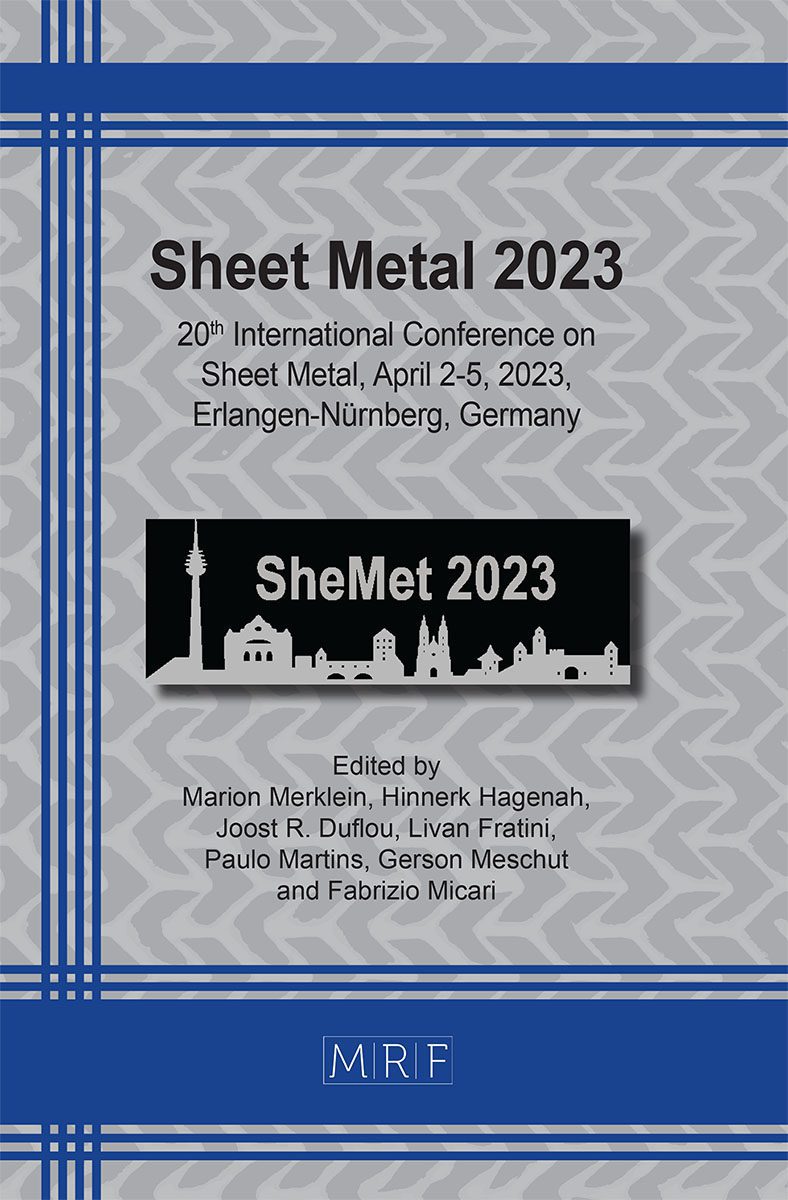Influence of distinct tool pin geometries on aluminum 8090 FSW joint properties
Harikrishna Rana, Vivek Patel, Gianluca Buffa, Livan Fratini, Rosa Di Lorenzo
download PDFAbstract. Aluminum Lithium alloys are recuperating substantial interest from automotive and aerospace industries owing to their extraordinary specific strength as compared to conventional aluminum (2xxx, 6xxx, and 7xxx) alloys. The goal of the present investigation is to study AA 8090 joints produced with the unique solid-state welding technique friction stir welding (FSW). Tool pin profile induces remarkable influence on friction and further plastic deformation during FSW. Therefrom, the influences of three distinct but constant dynamic area conditioned tool pin geometries namely, square trapezoidal, hexagonal trapezoidal, and threaded taper on the resulting material flow patterns, mechanical properties, and the microstructure have been studied and discussed in detail. The FSW joint produced with hexagonal trapezoidal pin geometry delivered the highest joint resistance owing to grain refinement and almost flawless microstructure.
Keywords
Friction Stir Welding, Aluminum, Pin Profile
Published online 3/17/2023, 8 pages
Copyright © 2023 by the author(s)
Published under license by Materials Research Forum LLC., Millersville PA, USA
Citation: Harikrishna Rana, Vivek Patel, Gianluca Buffa, Livan Fratini, Rosa Di Lorenzo, Influence of distinct tool pin geometries on aluminum 8090 FSW joint properties, Materials Research Proceedings, Vol. 25, pp 195-202, 2023
DOI: https://doi.org/10.21741/9781644902417-25
The article was published as article 25 of the book Sheet Metal 2023
![]() Content from this work may be used under the terms of the Creative Commons Attribution 3.0 licence. Any further distribution of this work must maintain attribution to the author(s) and the title of the work, journal citation and DOI.
Content from this work may be used under the terms of the Creative Commons Attribution 3.0 licence. Any further distribution of this work must maintain attribution to the author(s) and the title of the work, journal citation and DOI.
References
[1] Y. Tao, D. Ni, B. Xiao, Z. Ma, W. Wu, R. Zhang, Y. Zeng, Origin of unusual fracture in stirred zone for friction stir welded 2198-T8 Al-Li alloy joints, Materials Science and Engineering: A 693 (2017) 1-13. https://doi.org/10.1016/j.msea.2017.03.079
[2] B. Decreus, A. Deschamps, F. De Geuser, P. Donnadieu, C. Sigli, M. Weyland, The influence of Cu/Li ratio on precipitation in Al–Cu–Li–x alloys, Acta Mater. 61(6) (2013) 2207-2218. https://doi.org/10.1016/j.actamat.2012.12.041
[3] H. Liu, Y. Hu, C. Dou, D.P. Sekulic, An effect of the rotation speed on microstructure and mechanical properties of the friction stir welded 2060-T8 Al-Li alloy, Mater. Charact. 123 (2017) 9-19. https://doi.org/10.1016/j.matchar.2016.11.011
[4] H. Rana, D. Campanella, G. Buffa, L. Fratini, Dissimilar titanium-aluminum skin-stringer joints by FSW: process mechanics and performance, Mater. Manuf. Process (2022) 1-14. https://doi.org/10.1080/10426914.2022.2116044
[5] E. Lertora, C. Gambaro, AA8090 Al-Li alloy FSW parameters to minimize defects and increase fatigue life, International Journal of Material Forming 3(1) (2010) 1003-1006. https://doi.org/10.1007/s12289-010-0939-1
[6] M.P. Alam, A. Sinha, Fabrication of third generation Al–Li alloy by friction stir welding: a review, Sādhanā 44(6) (2019) 1-13. https://doi.org/10.1007/s12046-019-1139-4
[7] W. Thomas, E. Nicholas, Friction stir welding for the transportation industries, Mater. Des 18(4-6) (1997) 269-273. https://doi.org/10.1016/S0261-3069(97)00062-9
[8] G.F. Vander Voort, S.R. Lampman, B.R. Sanders, G.J. Anton, C. Polakowski, J. Kinson, K. Muldoon, S.D. Henry, W.W. Scott Jr, ASM handbook, Metallography and microstructures 9 (2004) 44073-0002. https://doi.org/10.31399/asm.hb.v09.9781627081771
[9] V.V. Patel, V. Badheka, A. Kumar, Effect of polygonal pin profiles on friction stir processed superplasticity of AA7075 alloy, J. Mater. Process. Technol. 240 (2017) 68-76. https://doi.org/10.1016/j.jmatprotec.2016.09.009
[10] H. Rana, V. Badheka, Elucidation of the role of rotation speed and stirring direction on AA 7075-B4C surface composites formulated by friction stir processing, Proceedings of the Institution of Mechanical Engineers, Part L: Journal of Materials: Design and Applications (0) (2017) 1-18. https://doi.org/10.1177/1464420717736548
[11] H. Rana, V. Badheka, A. Kumar, A. Satyaprasad, Strategical parametric investigation on manufacturing of Al–Mg–Zn–Cu alloy surface composites using FSP, Mater. Manuf. Process 33(5) (2018) 534-545. https://doi.org/10.1080/10426914.2017.1364752
[12] K. Elangovan, V. Balasubramanian, Influences of pin profile and rotational speed of the tool on the formation of friction stir processing zone in AA2219 aluminium alloy, Materials Science and Engineering: A 459(1-2) (2007) 7-18. https://doi.org/10.1016/j.msea.2006.12.124
[13] J.-Q. Su, T.W. Nelson, C.J. Sterling, Friction stir processing of large-area bulk UFG aluminum alloys, Scr. Mater 52(2) (2005) 135-140. https://doi.org/10.1016/j.scriptamat.2004.09.014
[14] V. Patel, W. Li, A. Vairis, V. Badheka, Recent development in friction stir processing as a solid-state grain refinement technique: microstructural evolution and property enhancement, Critical Reviews in Solid State and Materials Sciences 44(5) (2019) 378-426. https://doi.org/10.1080/10408436.2018.1490251































